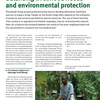Balancing livelihood needs and environmental protection
The people living around protected areas have to develop alternative livelihood sources to make a living. People on the forest fringe often depend on the utilisation of products and services provided by natural resources. The use of these formerly 'free' products is regulated and limited nowadays not least for environmental reasons.
How can a balance be achieved between the needs of the poor and the requirement to conserve the rich biodiversity? The article deals with livelihood adaptation capacities of households, alternative livelihood options and enhancing factors.
Dr Karin Gaesing
Technical University Dortmund
Department of spatial planning
Dortmund, Germany
karin.gaesing@tu-dortmund.de




